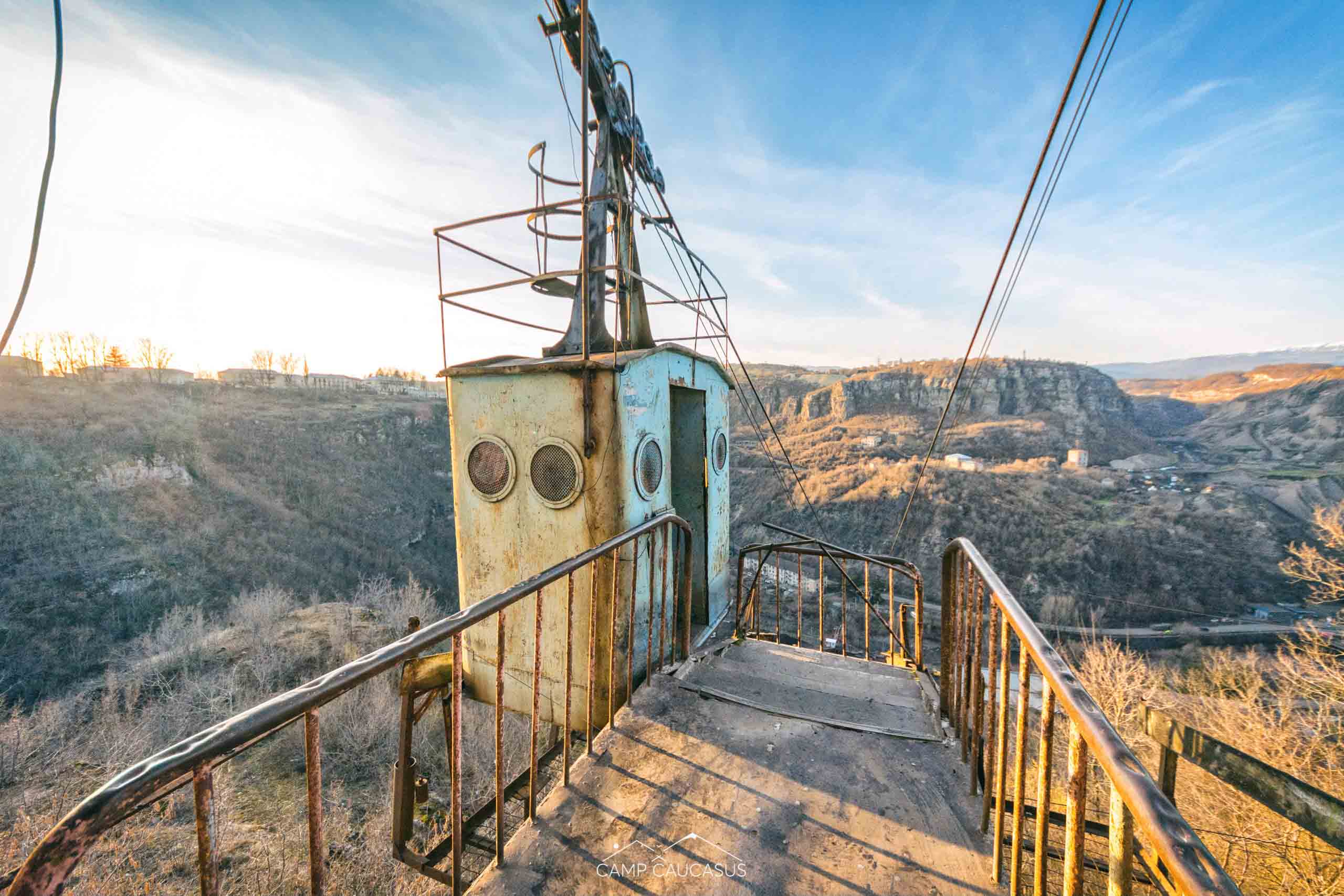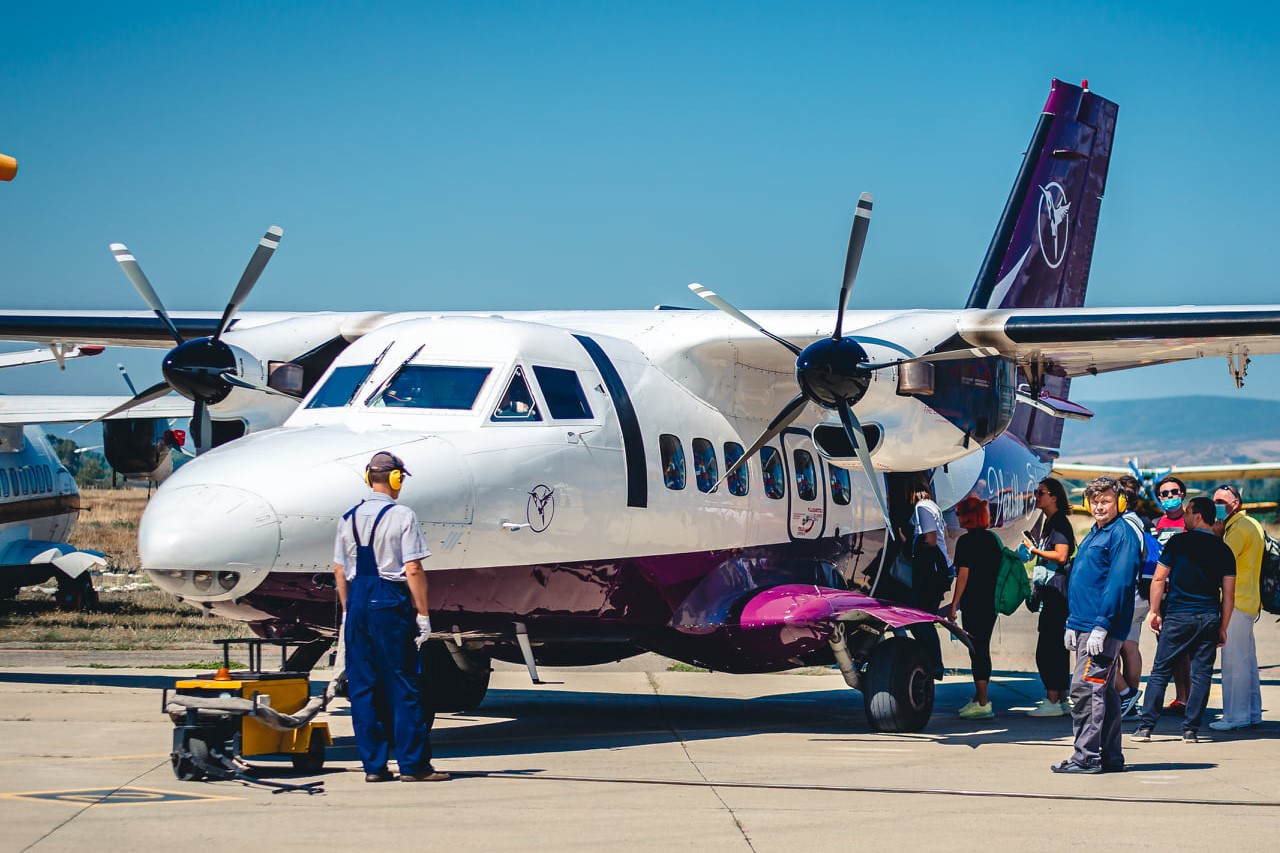Last updated: Apr 26, 2025
If you’re tired of the usual tourist spots and looking for something raw, real, and unforgettable, a trip to Chiatura, Georgia will transport you straight into the heart of Soviet industrial history. Known for its gravity-defying cable cars, brutalist architecture, and abandoned hospitals tucked into dramatic cliffs, Chiatura is one of the most unique towns in the Caucasus. It’s also home to Katskhi Pillar — a monolithic limestone column with a tiny church perched impossibly on top. Whether you’re here for the adventure or the atmosphere, this is a place that stays with you.
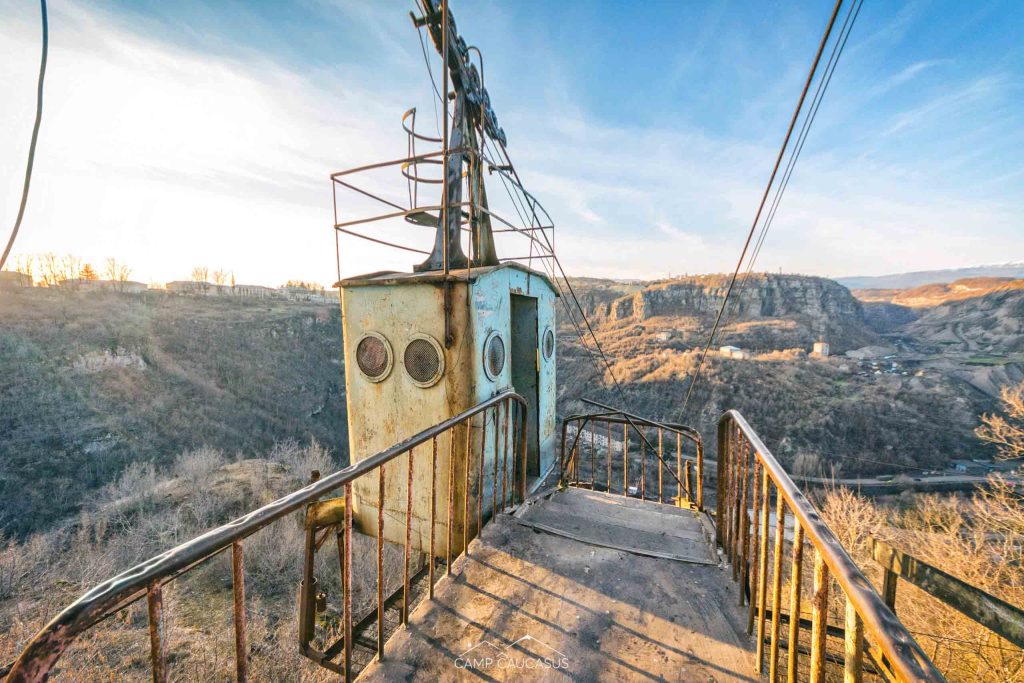
The two carriage ropeway “TSOPH – Avarioni” (1971)
History of Chiatura
The town is located along the river Kvirila. It’s surrounded by enormous rocks and beautiful landscapes. The development of Chiatura as a mining town began in the late 19th century. In 1846, German geologist Otto Wilhelm Hermann von Abich conducted geological studies in the area, identifying significant manganese deposits. However, it was the Georgian poet and public figure Akaki Tsereteli who, in 1879, initiated the industrial extraction of manganese. Tsereteli’s efforts attracted foreign investment, leading to the establishment of mining operations that transformed Chiatura into a significant center for manganese production. Numerous mines were opened here, and already in 1905, the manganese production was 60% of the global output. Stalin had a big role in developing Chiatura. Because of its relief, they needed something to carry manganese. So they built cable cars, and nowadays there are 20 rope-ways in Chiatura. Besides manganese and cable cars, this soviet brutalist architecture really brings back memories and transports you to the past.

Itkhvisi – Avarioni Ropeway, Chiatura, Georgia (1957)

What to see in Chiatura: Top attractions
There is a lot to see in Chiatura. From very natural to very artificial. But one of the top things to do in Chiatura is ride the cable cars, old and new. This is the most comfortable way to go to the rock or to the village. They were built in 1945 by Giorgi Pantsulaia. However, new cable cars are being built now, and they will be done soon. But everyone will agree that old ones have a special scent.
In October 2024, one of Chiatura’s most iconic historic cable cars — the line to Upper Rgani (also known as “Peace”) was officially relaunched. Originally built in 1966 under the guidance of engineer Giorgi Pantsulaia, this public aerial ropeway now holds cultural heritage status in Georgia. As the first of Chiatura’s old cable cars to be rehabilitated, it has been carefully restored with its original structure and Soviet-era design intact, while upgrading only the technical parts like the gondolas, machinery, and cables.
What makes this line especially remarkable is its 48-degree incline, the steepest passenger cable car in the post-Soviet space. The near-vertical ascent feels more like an elevator ride, offering thrilling views over the city’s dramatic gorge. It now operates daily and, unlike the newer lines, remains free to ride.
This brings the total number of functioning cable cars in Chiatura to five. Another historic line, the Perevisa gondola, is currently being restored and is expected to reopen in 2025.
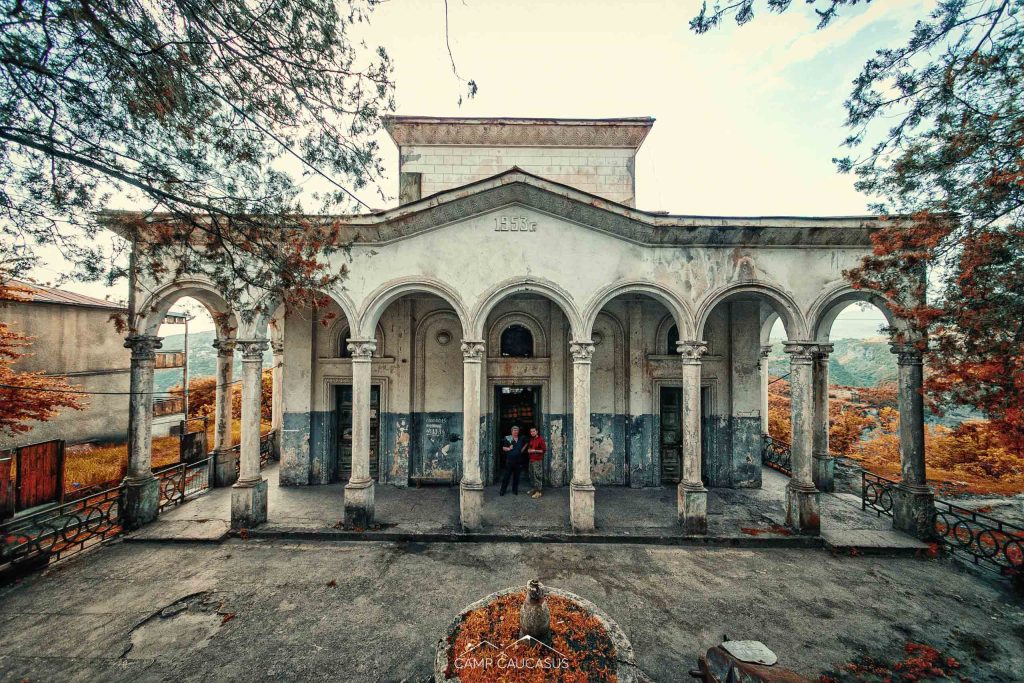
Chiatura Ropeway “Line-25” (1954)
Most town buildings were built in the soviet union. For example, the municipality building, which was built in 1979, and the Cultural Centre in 1968. Another glorious building is the Akaki Tsereteli Chiatura Theatre (1949). But one of the most mysterious parts of Chiatura is the abandoned places. Here you can find four abandoned post-Soviet hospitals and the Pioneer Palace that still maintains its greatness.

Pioneer Palace of Chiatura, Georgia
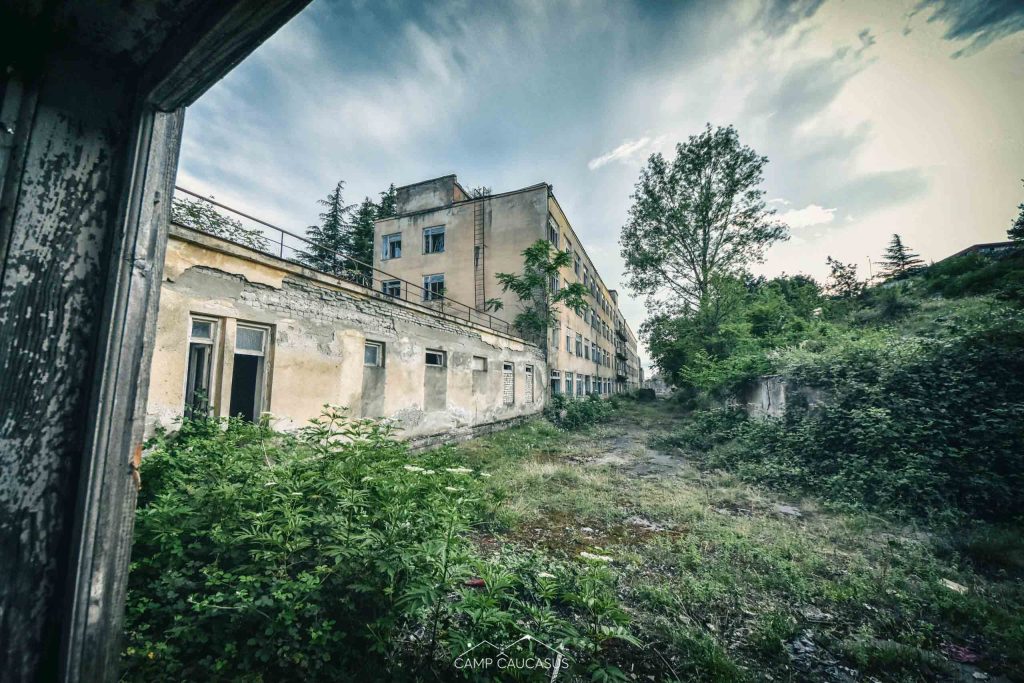
As you know, Georgia is full of churches and Chiatura is no exception, of course. Here you can see the majestic Monastery of Mghvimevi built in the early XIII century. Lovers of antiquity will find here interesting examples of old architecture. It is important for the nation and for the country as a whole. The monastery has become more widely known as the place where our ancestors have lived and blessed the country.

Visiting Katskhi Pillar
Katskhi is a village near the town. It’s popular with an amazing pillar. Katskhi pillar is a natural limestone monolith that towers more than 130 feet, or 40 meters, into the air and on top of which stands what is probably the world’s most isolated, and most sacred, churches (would be the best place to hide during Corona). The Katskhi complex is unique. At the top of the column is a church built in the 6th to 8th centuries, dedicated to Maximus the Confessor, a 7th-century monk. There’s also a burial chamber, a wine cellar, a curtain wall, and three hermit cells.
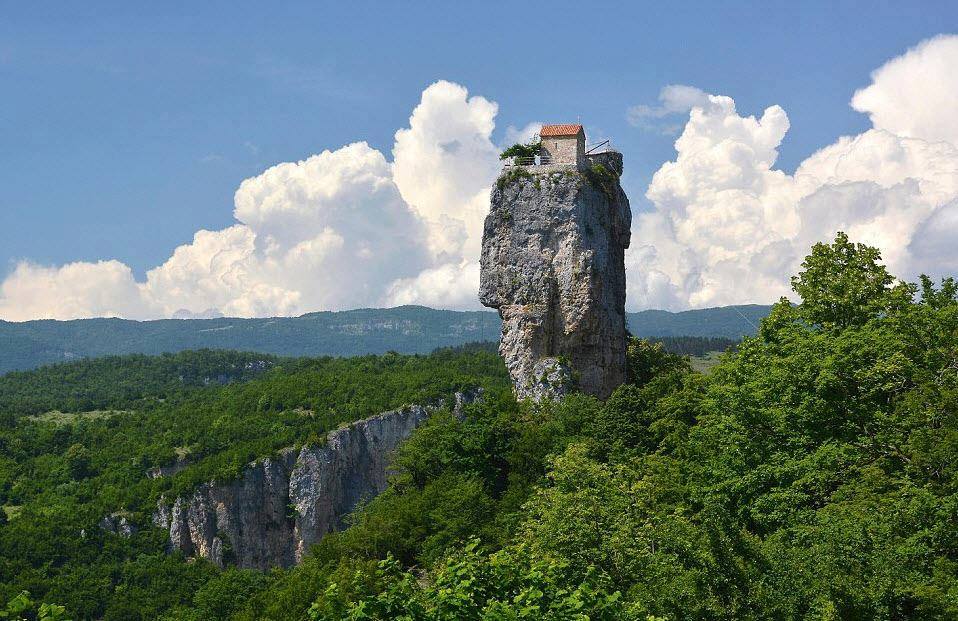
Katskhi pillar, Chiatura, Georgia
Located just 15 minutes from Chiatura, Katskhi Pillar is included in our 2-day private tour of Chiatura and Tskaltubo, making it easy to experience this surreal landmark up close.
Each day, monks living below make the nerve-jangling 20-minute ascent via a thin metal ladder bolted to the side of the rock. The daily pilgrimage to say prayers at the top is said to bring them closer to God. From the city center to Katskhi, it’s a 15-minute drive and you also have to walk a few metres before reaching the monastery. In the past, men were able to climb to the pillar, but nowadays almost no one is allowed to climb. But down there are still so many things to see because nature is astonishing too.
How to get to Chiatura?
There are many options to get to Chiatura. You can take Marshrutka from Tbilisi and it’s a 3-hour ride (150km) which will cost 10 GEL. From Kutaisi, it’s an hour and a half ride (75 km) for only 6 GEL. Also, you can take a train from Kutaisi, but it will be a 3-hour ride for only 1 GEL. But if you like adventures, you should try hitchhiking, it’s easy in Georgia, and you will probably meet many lovely locals.
Want to see it all with a local guide? Check out our Chiatura & Katskhi Urbex Tour.
Recent Articles
Day Trip to Chiatura: Cable Cars, Soviet Architecture & Katskhi Pillar
The city of cable cars and soviet brutalist architecture offers more than you think. Learn more about Tchiatura and its surroundings.
How to Travel to Mestia from Tbilisi, Kutaisi or Zugdidi in 2025
The detailed guide on how to get to Mestia from Tbilisi, Kutaisi, Zugdidi, or Batumi by Marshrutka, train, or plain. Plan trip to Svaneti!
Explore Tskaltubo’s Abandoned Sanatoriums in Georgia
Learn about Tskaltubo the city with abandoned soviet sanatoriums . How to get there, where to stay and what to see.

